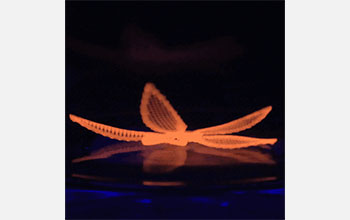Multimedia Gallery
Shapeshifting architectures inspired by nature
This image is one in a series of images showing the transformation of a 4D-printed hydrogel composite structure after its submersion in water.
More about this image
A team of scientists at the Wyss Institute for Biologically Inspired Engineering at Harvard University and the Harvard John A. Paulson School of Engineering and Applied Sciences has unveiled 4D-printed hydrogel composite structures that change shape upon immersion in water.
The team was inspired by nature, specifically, natural structures like plants, which respond and change their form over time according to environmental stimuli. The 4D-printed hydrogel composites, which mimick a variety of shape changes undergone by plant organs such as tendrils, leaves and flowers in response to environmental stimuli like humidity and temperature, are programmed to contain precise, localized swelling behaviors. The hydrogel composites contain cellulose fibrils that are derived from wood and are similar to the microstructures that enable shape changes in plants.
By aligning cellulose fibrils during printing, the hydrogel composite ink is encoded with anisotropic swelling and stiffness that can be patterned to produce intricate shape changes. The anisotropic nature of the cellulose fibrils gives rise to varied directional properties that can be predicted and controlled.
"This work represents an elegant advance in programmable materials assembly, made possible by a multidisciplinary approach," said Jennifer Lewis, a professor at Wyss and senior author of the study. "We have now gone beyond integrating form and function to create transformable architectures."
The new method opens up many new and exciting potential applications for 4D-printing technology including smart textiles, soft electronics, biomedical devices and tissue engineering.
The work was supported in part by the National Science Foundation's Materials Research Science and Engineering Center at Harvard University (under grant DMR 0820484).
Learn more in the Harvard SEAS news story Novel 4D printing method blossoms from botanical inspiration. (Date image taken: 2015; date originally posted to NSF Multimedia Gallery: March 7, 2016)
Credit: A.S. Gladman, E. Matsumoto, L.K. Sanders and J.A. Lewis, Wyss Institute at Harvard University
Images and other media in the National Science Foundation Multimedia Gallery are available for use in print and electronic material by NSF employees, members of the media, university staff, teachers and the general public. All media in the gallery are intended for personal, educational and nonprofit/non-commercial use only.
Images credited to the National Science Foundation, a federal agency, are in the public domain. The images were created by employees of the United States Government as part of their official duties or prepared by contractors as "works for hire" for NSF. You may freely use NSF-credited images and, at your discretion, credit NSF with a "Courtesy: National Science Foundation" notation.
Additional information about general usage can be found in Conditions.
Also Available:
Download the high-resolution JPG version of the image. (213.7 KB)
Use your mouse to right-click (Mac users may need to Ctrl-click) the link above and choose the option that will save the file or target to your computer.

 All images in this series
All images in this series